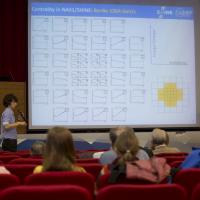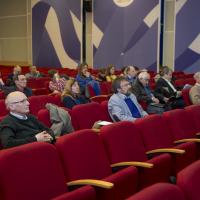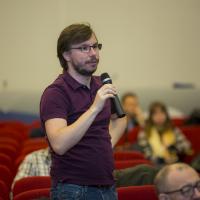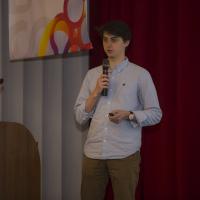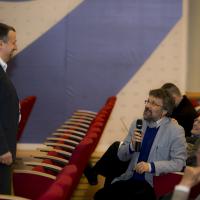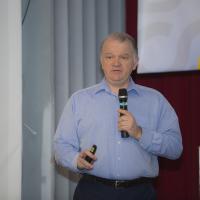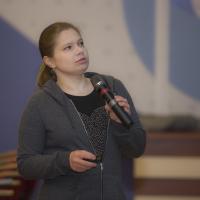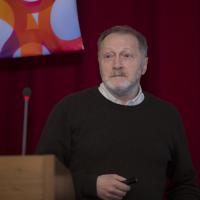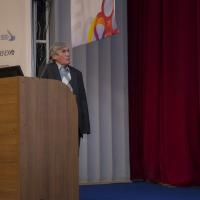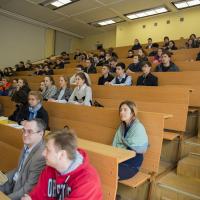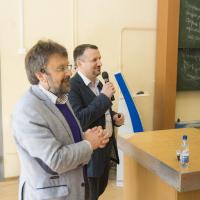At the beginning of May, the joint meeting of international NA61 / SHINE and NA49 collaborations has been held in MEPhI with the support of MEPhI, the Institute of Nuclear Research of the Russian Academy of Sciences, and the European Organization for Nuclear Research CERN. Among the participants there are more than 50 scientists from the leading scientific laboratories and universities of 8 countries of the world.

Similar meetings are held twice a year: autumn one is in CERN and spring one is at the site of one of the participating organizations. The event is a place for presenting overview reports on the state of the experiment, discussing new results and prospects. In particular, the participants discussed the modernization of the NA61/SHINE installation during the stopping of the Large Hadron Collider and the continuation of the experimental program after 2020.
The main goal of the NA61/SHINE and NA49 experiments is to study the properties of matter at very high temperatures and densities. Under such conditions, the structure of normal matter is completely destroyed and a new form is created with completely unexpected properties. The obtained results broaden our fundamental knowledge about nature, the universe, and potentially can find applied applications.
MEPhI has joined the NA61/SHINE collaboration just two years ago, but its participation is already very noticeable. Last year, on the initiative of MEPhI, data were collected on the collisions of relativistic heavy nuclei, which was not included in the original experimental program.
A feature of the MEPhI collection was a series of open lectures on the physics of collisions of relativistic heavy ions conducted at MEPhI and the Institute of Nuclear Research of the Russian Academy of Sciences Troitsk. This direction is one of the most promising in modern physics: it is being studied in the ongoing international projects LHC and RHIC, and also forms the basis of future mega-science projects NICA and FAIR. In particular, the speaker of the NA61/SHINE collaboration Marek Gazdzicki conducted an introductory lecture for the MEPhI lyceum students: "I told about the unusual properties of the microworld that we are studying, about the physics that is unusual for us, about what scientists are doing specifically, what they want to learn in the course of their research." In addition, schoolchildren learned the potential opportunities for international cooperation and participation in mega-projects.
Graduates and postgraduates of MEPhI actively participate in the processing of the accumulated NA61/SHINE and NA49 data, which is very welcome by both collaborations. “Our students presented their results at the poster session and their results were also covered in the joint report of group MEPhI - GSI Darmstadt. We showed that there are results, there are people, and, most importantly, there are young people in MEPhI, who are interested in doing experiments in this field,” said Ilya Selyuzhenkov, an associate professor of Condensed matter physics Department at MEPhI. Holding a meeting of international collaborations at MEPhI is very important for students who see the reality of world-class projects where they can take a direct part. Besides full-fledged scientific activity, it is an opportunity for young people to establish new contacts and connections with other laboratories, which will help them in their further scientific career. "We plan to develop this direction in MEPhI and create a full-fledged training program for bachelors, masters and graduate students, which will help grow our own specialists,” Ilya Selyuzhenkov said.
Thousands of new particles are created in relativistic collisions of heavy nuclei. As a result of the experiment, a huge amount of information is accumulated about the production of particles in millions of collisions of nuclei. Its processing requires supercomputers, which are both in CERN, and in GSI in Darmstadt, and in other scientific centers of the world. MEPhI plans to create a data processing infrastructure where students could analyze experimental data on a small supercomputer during their training. Now many Russian groups lag behind their foreign counterparts in this direction, as a result of which they are poorly represented at conferences with reports on the results of data processing. “We hope that we can compensate for this shortcoming, make MEPhI the leader in this direction. MEPhI has talented young people, and groups of other Russian laboratories (INR RAS Troitsk, JINR Dubna), with whom we develop cooperation, have extensive experience in conducting experiments and this is good for our cooperation and youth training.”
Marek Gazdzicki shared his impressions about the first meeting of international collaborations NA61/SHINE and NA49 at MEPhI:
The meeting of collaborations turned out to be very rich, rich in various events: we visited MEPhI and the INR RAS Troitsk. The reports were very interesting. MEPhI presented its first results, and they look promising. There were very interesting excursions in MEPhI: we visited the scientific and educational center NEVOD, the computer center "Cherenkov" and MEPhI Nanocenter. I was especially impressed by the number of young people from MEPhI and St. Petersburg State University, not only graduate students, but also bachelors and masters – all levels were represented here. This is what universities are rich in, and what research centers lack.
The meeting was very successful, I am very glad that almost all the groups of the collaboration arrived and so many young people from Russia took part in it.





